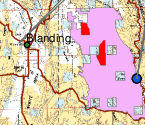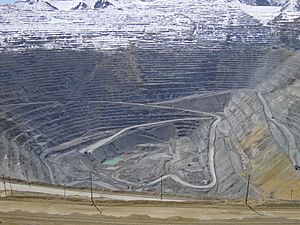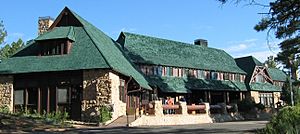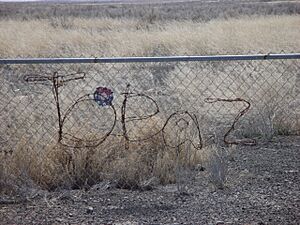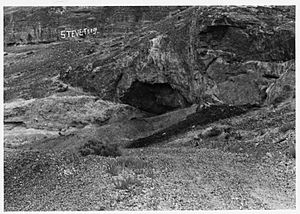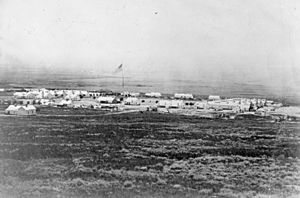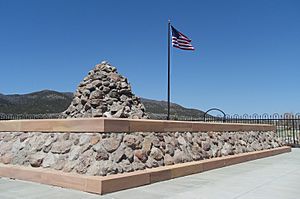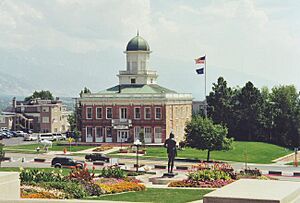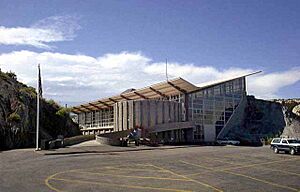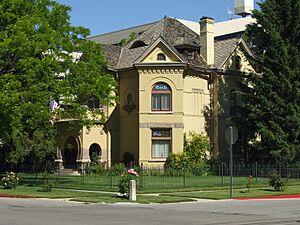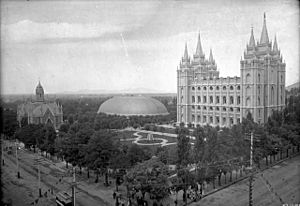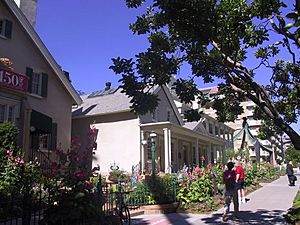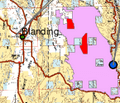List of National Historic Landmarks in Utah facts for kids
Did you know that the United States has special places called National Historic Landmarks? These are important buildings, areas, objects, or sites that tell amazing stories about American history. The National Park Service helps find and protect these landmarks.
The state of Utah is home to 14 of these special places. They show us many different parts of history, from ancient peoples to important events and famous leaders. Let's explore some of these cool landmarks!
Utah's Amazing Historic Landmarks
Alkali Ridge: Ancient Homes
Near Blanding, you can find the remains of very old homes at Alkali Ridge. These are some of the earliest buildings made by the Ancestral Puebloans. Long ago, people lived in simple pit houses. But here, they started building bigger, multi-story homes and special round rooms called kivas.
This site shows how people changed from moving around a lot to settling down and farming. Archaeologists have found beautiful pottery here. Alkali Ridge is so important that it helps us understand a whole period of history, from about the 10th to 11th centuries!
Bingham Canyon Mine: A Giant Hole
The Bingham Canyon Mine is located in the Oquirrh Mountains. It's the world's first and largest open-pit copper mine! Imagine a giant bowl dug into the earth – that's what an open-pit mine looks like.
This mine started operating in 1904. It has produced a huge amount of copper, which is used in many things, from wires to coins. It's a truly massive place that shows how much we can change the landscape to get important resources.
Bryce Canyon Lodge: Park History
Inside Bryce Canyon National Park, you'll find the beautiful Bryce Canyon Lodge. It was built between 1924 and 1927 by the Union Pacific Railroad. This lodge has a special style of architecture.
Railroads often built lodges like this in national parks across the American West. They wanted to encourage people to visit these amazing natural places. The lodge is a great example of how people enjoyed national parks long ago.
Topaz War Relocation Center: A Difficult Time
Near Delta, you can visit the site of the Central Utah Relocation Center, also known as Topaz. This was one of ten places where Japanese Americans were sent during World War II. Many families from northern California and the San Francisco Bay Area were forced to live here.
It was a very challenging time for these families. Many professional artists were among those held at Topaz. The site helps us remember this important and difficult part of American history.
Danger Cave: Ancient Discoveries
Near Wendover, there's a place called Danger Cave. This cave is an important archaeological site. It has helped scientists learn a lot about how people lived in the Great Basin area thousands of years ago.
Archaeologists have found many ancient tools and other items inside the cave. These discoveries tell us about the early people who lived in Utah and how they survived in this environment.
Desolation Canyon: River Adventures
Desolation Canyon is a remote and wild canyon on the Green River. This amazing place was explored by John Wesley Powell in 1869. His famous expedition was supported by the Smithsonian Institution.
Powell's journey through this canyon was a big adventure. He was one of the first to map and describe this rugged part of the American West. The canyon remains a beautiful and wild place today.
Emigration Canyon: Pioneer Journey
Emigration Canyon is a very important place in Salt Lake City's history. This is the canyon through which the Mormon pioneers traveled when they reached the Wasatch Range. Starting in 1847, they came through this canyon at the end of their long trail.
It was here that Brigham Young famously said, "This is the place." This canyon marks the end of a long journey and the beginning of a new settlement for many pioneers.
Fort Douglas: A Military Post
Fort Douglas is a historic US Army post in Salt Lake City. It was built in the 1860s. Its main jobs were to make sure the United States government's rules were followed in the Mormon territories. It also helped protect important travel and communication routes across the land.
This fort played a role in the early history of Utah and the relationship between the settlers and the U.S. government.
Mountain Meadows Massacre Site: A Place of Remembrance
Near Central, you can find the Mountain Meadows Massacre Site. This is where a tragic event happened in 1857. A group of pioneers traveling to California were attacked by the Utah territorial militia.
The site is now a place to remember those who lost their lives. It helps us learn about a difficult moment in Utah's past and the importance of peace and understanding.
Old City Hall: Utah's Early Government
The Old City Hall in Salt Lake City was finished in 1866. This building was not only the city hall but also served as the capitol of the Utah Territory. This means it was where the government of Utah was located before it became a state.
Many important discussions and sometimes disagreements happened here between Mormon leaders and the United States government. It's a building that saw a lot of history unfold!
Quarry Visitor Center: Dinosaur Bones!
The Quarry Visitor Center is located at Dinosaur National Monument. It was built as part of a special program by the National Park Service called Mission 66. This program aimed to build modern buildings in US national parks.
What's cool about this visitor center is that it was built right next to the dinosaur bones! This allowed visitors to see the fossils exactly where they were found. The building had some structural problems and was closed for a while, but a new center was built to continue showing off these amazing dinosaur discoveries.
Reed O. Smoot House: A Senator's Home
In Provo, you can see the home of Reed Smoot. He lived here from 1892 until he passed away in 1941. Reed Smoot was a very important US Senator.
He was known for supporting "protectionism," which means he wanted to protect American businesses from foreign competition. He is especially remembered for the Smoot-Hawley Tariff Act, a law about taxes on goods coming into the country. His home tells a story about American politics in the early 20th century.
Temple Square: A Spiritual Center
Temple Square in Salt Lake City is a very important place for the Church of Jesus Christ of Latter-day Saints. It was started in the mid-19th century. The square has several famous buildings.
These include the beautiful Salt Lake Temple, the large Tabernacle (known for its amazing acoustics), and the Assembly Hall. Temple Square is a peaceful and historic place that attracts visitors from all over the world.
Brigham Young Complex: A Leader's Home
The Brigham Young Complex in Salt Lake City includes two historic homes: the Beehive House and the Lion House. These were the homes of Brigham Young from 1852 until he died in 1877.
Brigham Young was the President of the Church of Jesus Christ of Latter-day Saints when the Salt Lake Valley was settled. His homes were central to the growth of the Church, the development of Utah, and the shaping of the American West. They are important symbols of pioneer history.
Images for kids
See also


